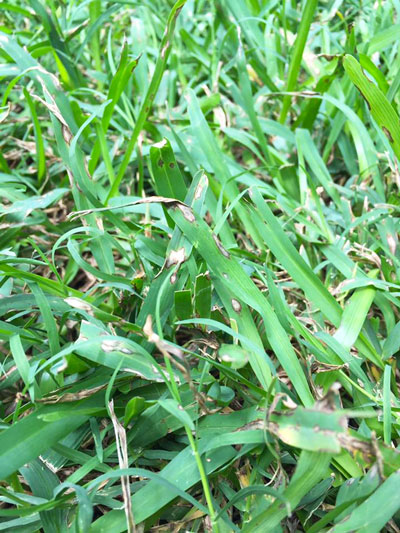Question of the Week: June 2, 2016
“Neil, why is my St. Augustine looking this way? Parts of my lawn are yellow and almost look hungry – but feeding doesn’t help.”
Simple answer: This is gray leaf spot. Look at the photo, then look at the symptoms below.

These are the gray-brown, roughly diamond-shaped lesions that most identify the gray leaf spot fungus on St. Augustine.
Symptoms:
• Blades have diamond-shaped, gray-brown lesions, often along midribs, but also on runners.
• Grass appears withered or yellow from a distance.
• Appears in irregular areas, often looking like it has washed across the lawn.
I learned about this fungal disease the hard way – in my own yard. That was 20 years ago. My grass was lethargic in irregularly shaped “washes” across the lawn. It was yellow when viewed from a distance, yet when I fertilized it, it didn’t get better.
That’s when I called my friend the late Dr. James McAfee, turf specialist with the Extension Service in Dallas. Jim and I had known each other since the second grade. We played Little League ball together. Our dads taught together at Texas A&M, his in Agronomy and mine in Range Management. We both graduated from Big 10 universities, he from Purdue and I from Ohio State. We became area specialists with the Extension Service the same day in 1972, and we shared the same secretary. We left TAMU employment on the same day in December, 1977, he to go with TruGreen and I to do commercial radio. (He later came back to TAMU.)
So back to the mid-1990s. Replying to my shout-out for help, Jim said, “Neil. You need to lay off nitrogen on your St. Augustine during the summer. This disease shows up after you apply nitrogen. Fungicides might help short-term, but you’re applying too much nitrogen in the summer.”
I did as instructed, and the problem never returned. That was when I started suggesting to listeners and readers who had St. Augustine turf that they apply high-nitrogen fertilizer to their lawns in mid-April, mid-June and not again until mid-September.
The lead photo for this story was posted on my Facebook page earlier this week. And yes, I know it’s not mid-June yet, so the disease is showing up a little early at least for this one year (probably due to the very mild winter). But, my answer hasn’t changed since our state’s finest turf expert set my thinking straight.
